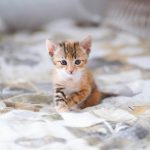Calico fabric is a durable, breathable cotton textile originally from India’s Calicut city, known for its simple, unbleached look and printed patterns. You’ll find it sturdy yet softens with washing, making it perfect for crafts, clothing, and home décor. It’s easy to care for with gentle washing and air drying. If you want to know how it’s made, its unique properties, and the best ways to use and care for it, you’re in the right place.
Table of Contents
Key Takeaways
- Calico fabric is a plain-woven, unbleached cotton textile originally from Calicut, India, known for its natural off-white shade and printed patterns.
- It is made by tightly spinning cotton yarns, bleaching or washing the fabric, and printing designs using wooden blocks or screen printing.
- Calico is sturdy, breathable, slightly coarse initially but softens with washing, and highly absorbent, making it ideal for dyeing and crafting.
- Commonly used for tote bags, quilting, simple garments, home décor, and sewing practice or prototypes due to its durability and affordability.
- Care involves gentle washing in cold or lukewarm water, avoiding bleach, air drying, and storing away from direct sunlight to prevent fading.
The History and Origin of Calico Fabric
Calico fabric traces its roots back to the city of Calicut (now Kozhikode) in India, where it was first produced centuries ago. You’ll find that calico originally featured simple, unbleached cotton with printed patterns, making it popular in both local markets and international trade.
When you explore history, you’ll see European traders brought calico to their countries in the 17th century, sparking widespread demand. You mightn’t know that calico’s affordability and versatility made it a staple for clothing and household textiles, especially in England and America.
Over time, calico evolved from a modest fabric into an essential part of textile history. So, when you use calico today, you’re connecting with centuries of cultural exchange and craftsmanship that began in India.
How Calico Fabric Is Made
Understanding how this fabric is made helps you appreciate the craftsmanship behind its timeless appeal.
Calico starts with plain-woven cotton fibers, usually unbleached or minimally processed. You’ll find that the cotton yarns are tightly spun, creating a sturdy yet breathable textile.
Once woven, the fabric often undergoes a bleaching or washing process to soften it. If you want patterned calico, the cloth is printed with simple, repetitive designs using natural or synthetic dyes.
This printing can be done with wooden blocks or screen printing techniques, depending on the desired look. After printing, the fabric is dried and sometimes treated to fix the dyes, ensuring colorfastness.
This straightforward process results in the affordable, versatile fabric you recognize as calico.
Characteristics and Properties of Calico
Although it may seem simple at first glance, this fabric boasts several qualities that make it a favorite for many uses.
Calico is a plain-woven cotton fabric that feels sturdy yet breathable, giving you comfort without sacrificing durability. You’ll notice its slightly coarse texture, which softens with washing, making it more pleasant over time.
It’s unbleached or minimally processed, so it often carries a natural off-white shade with visible weave patterns. Calico is also highly absorbent, which means it dyes easily if you want to customize its look.
Plus, it resists tearing and fraying better than many lightweight fabrics. Since it’s affordable and easy to work with, you’ll find calico flexible for projects that demand reliability and straightforward handling.
Common Uses of Calico Fabric
The fabric’s durability and absorbency make it a go-to choice for a variety of everyday and creative projects.
When you use calico, you’ll find it’s perfect for both practical and artistic purposes. Its plain weave and natural look give you a versatile canvas to work with.
Here are some common uses you might consider:
- Making tote bags and reusable shopping bags
- Creating quilting blocks and patchwork designs
- Sewing simple garments or linings for clothes
- Crafting home décor items like curtains or pillow covers
- Practicing sewing skills or making prototypes before using expensive fabrics
With calico, you get an affordable, sturdy fabric that’s easy to handle, making it ideal for beginners and seasoned crafters alike.
How to Care for and Maintain Calico
To keep your calico fabric looking fresh, you’ll want to follow some simple washing tips like using cold water and gentle cycles.
Avoid harsh detergents to prevent fading and wear.
When storing, make sure it’s in a cool, dry place away from direct sunlight to maintain its quality.
Washing Tips
When you care for calico properly, it keeps its softness and vibrant patterns longer. To wash calico, use cool or lukewarm water and a gentle detergent to avoid fading or shrinking. Avoid bleach, as it damages the fabric’s color and fibers. Hand washing is ideal, but if you use a machine, select a gentle cycle.
After washing, air dry calico instead of using a dryer to prevent stiffness and shrinkage.
Here are some quick washing tips for calico:
- Use mild detergent without bleach
- Wash in cool or lukewarm water
- Choose gentle hand wash or machine cycle
- Avoid wringing; gently squeeze out excess water
- Air dry flat or hang to maintain shape
These steps help your calico fabric stay fresh and durable.
Storage Recommendations
Although calico is durable, proper storage plays a key role in preserving its texture and color. You should store your calico fabric in a cool, dry place away from direct sunlight to prevent fading and weakening of the fibers. Avoid plastic bags, as they trap moisture and can cause mildew. Instead, use breathable cotton bags or wrap the fabric in acid-free tissue paper. Keep it folded neatly to avoid permanent creases.
| Storage Tip | Why It Matters | How To Do It |
|---|---|---|
| Cool, Dry Place | Prevents mold & mildew | Choose a shaded, ventilated spot |
| Avoid Plastic Bags | Stops moisture buildup | Use cotton bags or tissue paper |
| Fold Neatly | Avoids creases | Fold along natural lines |
Differences Between Calico and Similar Fabrics
Since calico shares qualities with several other fabrics, you might find it tricky to tell them apart at first.
Understanding the differences helps you choose the right fabric for your project. Here’s how calico compares to similar materials:
- Muslin: Calico is usually coarser and printed, while muslin is finer and often plain.
- Canvas: Canvas is heavier and more durable; calico is lighter and softer.
- Linen: Linen has a distinct texture and sheen; calico is matte and rougher.
- Chambray: Chambray looks like denim but is lighter; calico has simple prints or plain weaves.
- Poplin: Poplin is tightly woven and smooth; calico is loosely woven and rough.
Knowing these differences guarantees you pick the perfect fabric to match your needs.
Tips for Choosing the Right Calico for Your Project
Choosing the right calico can make or break your project’s outcome, so you need to contemplate factors like weave tightness, weight, and print type carefully. For example, a tighter weave offers durability, while a looser one is more breathable. Consider the fabric’s weight depending on whether you want a sturdy bag or a light dress. Also, think about the print—plain calico suits dyeing or painting, while printed calico works well for ready-to-use designs.
| Factor | Description | Best For |
|---|---|---|
| Weave Tightness | Tight or loose weave | Durability vs. breathability |
| Weight | Light, medium, heavy | Clothing vs. upholstery |
| Print Type | Plain or printed | Customization vs. instant pattern |
Match these factors to your project needs for best results.
Frequently Asked Questions
Can Calico Fabric Be Used for Upholstery?
Sure, go ahead and upholster your throne with calico—because who needs durability when you can have charmingly thin fabric? But seriously, calico works for light-use furniture, though it’s less tough than traditional upholstery fabrics.
Is Calico Fabric Eco-Friendly or Sustainable?
You’ll find calico fabric eco-friendly if it’s made from organic cotton and produced sustainably. It’s biodegradable and uses minimal processing, but conventional calico may involve pesticides and chemicals, so always check the source before buying.
How Does Calico Fabric React to Dyeing at Home?
Dyeing calico fabric at home delivers delightful, dynamic results. Because it’s plain and porous, you can confidently create colorful crafts, though colors might appear lighter. Just soak, stir, and soak again for striking shades!
Can Calico Fabric Be Used in Food Preparation or Storage?
You can use calico fabric in food preparation and storage, especially for wrapping or covering food. Just make sure it’s clean, untreated, and free from harmful dyes or chemicals to keep your food safe and fresh.
What Are the Best Sewing Techniques for Calico Fabric?
Like a painter choosing brushes, you’ll want to use straight stitches and French seams for calico’s durability. Pre-wash your fabric to avoid surprises, and press seams open—these steps guarantee your project holds up beautifully.
- How to Find Discontinued or Outlet Mulberry Home Fabrics - June 21, 2025
- The Interior Designer’s Guide to Mulberry Fabrics & Wallpapers - June 21, 2025
- An Introduction to Mulberry Tweed Fabric for Fashion and Interiors - June 21, 2025







